- BOAT OF THE YEAR
- Newsletters
- Sailboat Reviews
- Boating Safety
- Sailing Totem
- Charter Resources
- Destinations
- Galley Recipes
- Living Aboard
- Sails and Rigging
- Maintenance


Columbia 30
- By Ralph Naranjo
- Updated: April 7, 2006
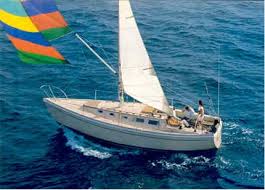
Not only is the Columbia Yachts logo back in business; Vince Valdes, the son of Columbia’s founder, now heads the company, and his new boat is faster and more fun to sail than its predecessors.
This boat is anything but your father’s classic Columbia 34. Introduced at the 2004 U.S. Sailboat Show in Annapolis, Maryland, the trailerable Columbia 30 is a no-nonsense sportboat that can serve as a club racer or a performance cruiser that trades amenities for sailing thrills. The berths are comfortable, and there’s a head, a small dinette table, and a rudimentary galley, but under sail is where this boat shines.
Initially, I was a little disappointed when I put the boat on a close reach in 10 to 15 knots true. We only managed to stay even with a particular 37-foot cruiser not known for alacrity. We luffed up, and two Chesapeake Bay crab-pot buoys surfaced. Free of this handicap, the Columbia 30 vaulted by the cruiser and picked off large cruising multihulls on a reach. The tiller had a fingertip feel, and foot chocks provided a comfortable position when heeling. It was clear this boat would appeal to a performance-oriented cruiser looking for an agile sloop that excels in the light summer conditions found in many of North America’s popular sailing venues.
Designer Tim Kernan leveraged such go-fast attributes as a carbon spar, a retractable keel with 2:1 purchase, and a retractable carbon-fiber bowsprit. There’s a 1,400-pound lead bulb at the tip of the keel foil and a hoisting mechanism that reduces the 7-foot draft of a weatherly performer to the 2-foot draft of a trailer-sailer.
For the hull, Columbia uses bias-biaxial fiberglass that’s vacuum bagged to a PVC foam core and infused with vinylester resin. The deck is built from balsa-core sandwich and reinforced with a carbon-fiber space frame that helps to spread rig and keel loads.
In many ways, the boat behaves like a blend between a sportboat and a pocket cruiser. Its light displacement, substantial sail area, and easily driven hull shape actually simplify sailing. The Columbia 30 has a simple sail plan, with a dominant main and a small jib on a roller-furling headstay. The retractable bowsprit allows a shorthanded crew to cope with an asymmetric spinnaker and will coax a fun sail out of 5 knots of breeze.
Down below, simplicity reigns with two comfortable quarter berths, a forward V-berth, an enclosed head, and a small galley space with a sink and a one-burner stove–perhaps all you need if your preference is marina-based daysailing and dining out.
The standard auxiliary is a 9.1-horsepower Yanmar 1GM10C with saildrive that produces adequate thrust in a calm. An optional 18-horsepower two-cylinder Yanmar diesel is available. The Columbia 30’s streamlined styling alludes to the bubble top and bullet window that typified earlier Columbias.
This boat is all about blistering performance and simple, practical accommodations. If you really like to sail fast, and your cruising isn’t about all the comforts of home, it’s worth going for a ride aboard the new Columbia 30.
Circumnavigator Ralph Naranjo has written extensively about boat design and performance.
COLUMBIA 30
LOA 30′ 0″ (9.14 m.) LWL 27′ 0″ (8.23 m.) Beam 9′ 6″ (2.90 m.) Draft (board down/up) 7′ 0″/2′ 0″ (2.13/0.61 m.) Sail Area 443 sq. ft. (41.2 sq. m.) Displacement 3,900 lb. (1,773 kg.) Water 9 gal. (34 l.) Fuel 12 gal. (45 l.) Engine 9.1-hp. Yanmar (18-hp. optional) Designer Tim Kernan (Waterplane Design) Price $131,250
Columbia Yachts (714) 227-9212 www.columbiayachts.com
- More: 21 - 30 ft , before 2000 , Coastal Cruising , keelboat , monohull , Sailboat Reviews , Sailboats
- More Sailboats
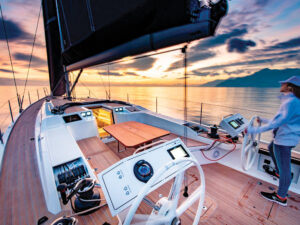
Sailboat Review: Italia Yachts 14.98
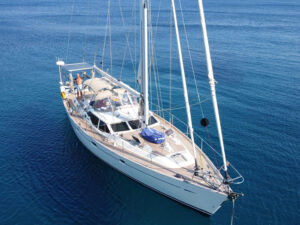
For Sale: 2000 Oyster 53
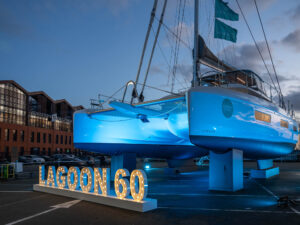
Lagoon 60 Prepares for World Premiere
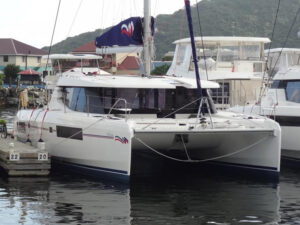
Now For Sale: Leopard 45
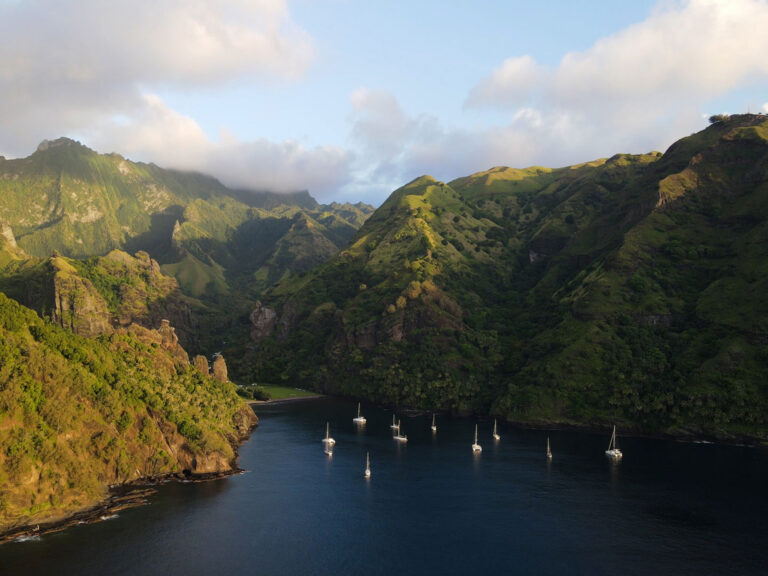
Dodging Storms, Chasing Thrills in French Polynesia
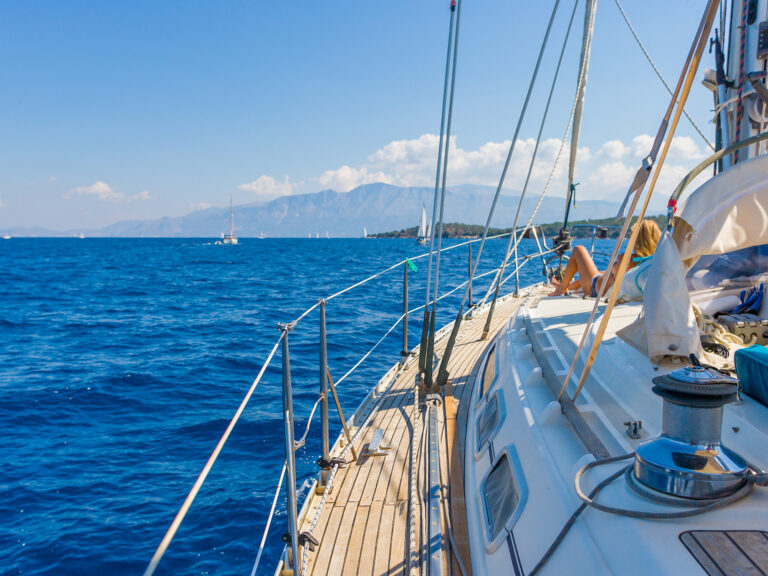
Southern Comfort: Technical Advice for Sailing South
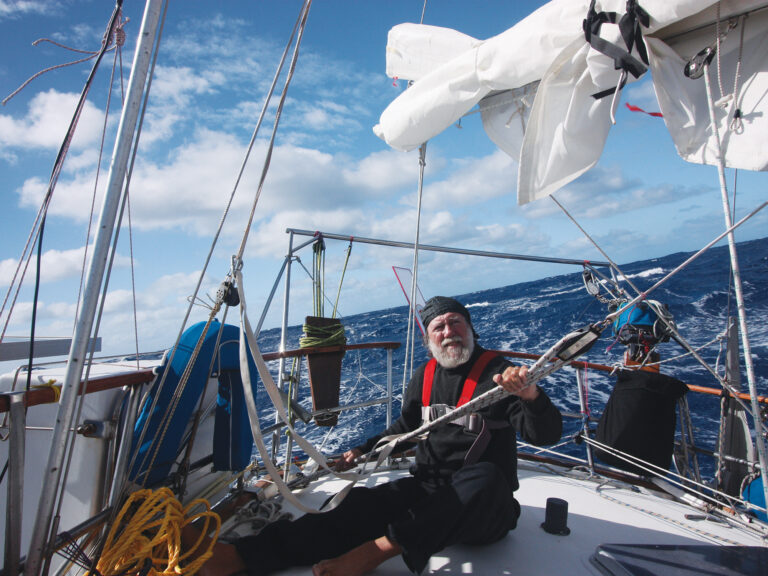
Learning the Art of Seamanship
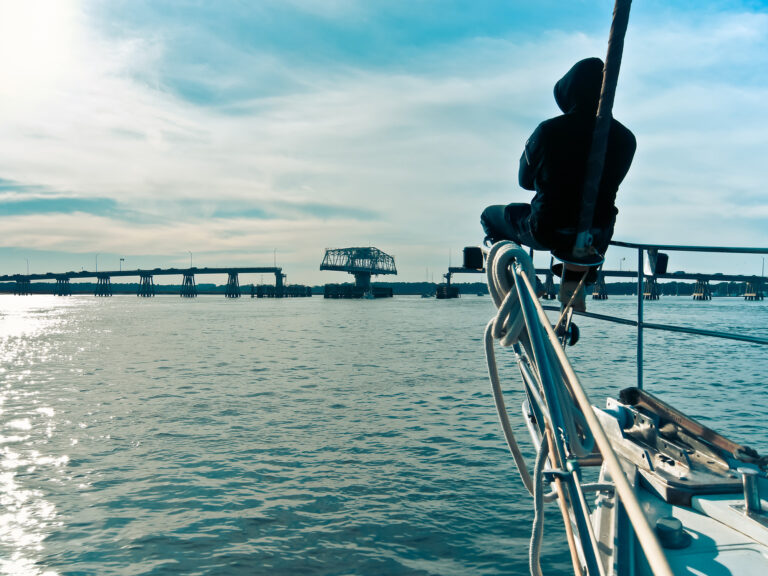
ICW Boaters Will Benefit from $48.5M Dredging Funding
- Digital Edition
- Customer Service
- Privacy Policy
- Email Newsletters
- Cruising World
- Sailing World
- Salt Water Sportsman
- Sport Fishing
- Wakeboarding
Columbia 30
The columbia 30 is a 30.0ft masthead sloop designed by william tripp jr. and built in fiberglass by columbia yachts between 1971 and 1973., 287 units have been built..
The Columbia 30 is a moderate weight sailboat which is a reasonably good performer. It is reasonably stable / stiff and has an excellent righting capability if capsized. It is best suited as a bluewater cruising boat.
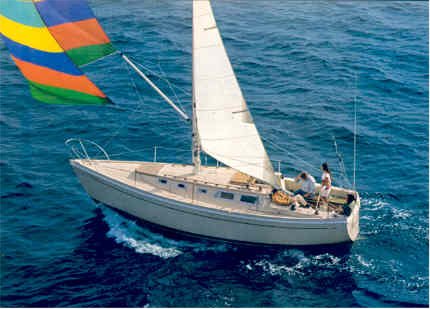
Columbia 30 for sale elsewhere on the web:

Main features
Login or register to personnalize this screen.
You will be able to pin external links of your choice.

See how Sailboatlab works in video

We help you build your own hydraulic steering system - Lecomble & Schmitt
Accommodations
Builder data, other photos.
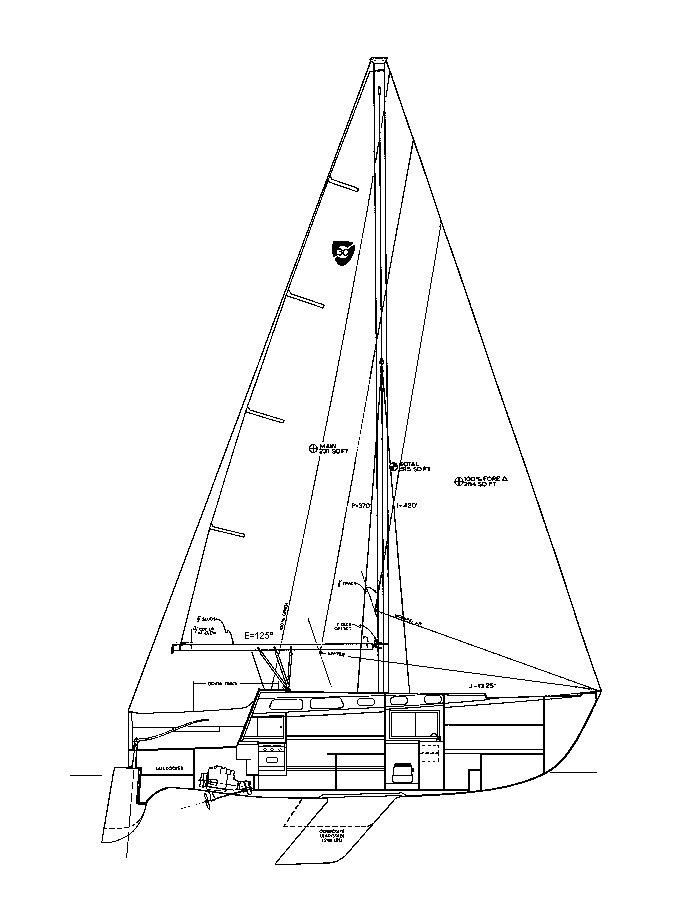
Modal Title
The content of your modal.
Personalize your sailboat data sheet
COLUMBIA 30 Detailed Review

If you are a boat enthusiast looking to get more information on specs, built, make, etc. of different boats, then here is a complete review of COLUMBIA 30. Built by Columbia Yachts and designed by William H. Tripp Jr., the boat was first built in 1971. It has a hull type of Fin with rudder on skeg and LOA is 9.14. Its sail area/displacement ratio 16.92. Its auxiliary power tank, manufactured by undefined, runs on undefined.
COLUMBIA 30 has retained its value as a result of superior building, a solid reputation, and a devoted owner base. Read on to find out more about COLUMBIA 30 and decide if it is a fit for your boating needs.
Boat Information
Boat specifications, sail boat calculation, rig and sail specs, contributions, who designed the columbia 30.
COLUMBIA 30 was designed by William H. Tripp Jr..
Who builds COLUMBIA 30?
COLUMBIA 30 is built by Columbia Yachts.
When was COLUMBIA 30 first built?
COLUMBIA 30 was first built in 1971.
How long is COLUMBIA 30?
COLUMBIA 30 is 8.08 m in length.
What is mast height on COLUMBIA 30?
COLUMBIA 30 has a mast height of 11.28 m.
Member Boats at HarborMoor

- Forum Listing
- Marketplace
- Advanced Search
- About The Boat
- Boat Review Forum
- SailNet is a forum community dedicated to Sailing enthusiasts. Come join the discussion about sailing, modifications, classifieds, troubleshooting, repairs, reviews, maintenance, and more!
1973 Columbia 30
- Add to quote
I'm interested in a 1973 columbia 30' sailboat, and was wondering if anyone out there has any experiance with them or can give me any advice. Thanks.
Sailed on one that had, at some point, been to Mexico and back to the PNW. Found it to be a solid feeling boat, no rocketship but seemed comfortable in a reasonable breeze. Good headroom and reasonable accommodation though as I recall the galley was a bit minimal (at least on that one) They probably go for a relatively low price for that size of boat. And, of course, Survey, survey, survey......
Sailed on one for 17 years as owner. Single-handed her from S.F. Ca to Cabo, and over to P.V. Mexico with a friend, and back to Cabo. I just about wore out S.F. Bay herself with all the miles I sailed her there. I lived on the boat alone for nearly a decade. Was roomy for 2 when love was in the air. Not roomy enough when argueing though. She was a shoal draft, and sailed straight as an arrow down the face of 20ft. waves rounding Point Conception with the tiller pilot on. She did crack the liner on the floor while dropping off the face of some 15ft. steep waves for 18 hours. Some plywood, epoxy, and paint did her right though. Strong, and capable is how I would describe her...... i2f
- ?
- 174.7K members
Top Contributors this Month
- Choose the kind of boat Big boats Motor boats Rubber boats Sailing boats Sailing multihull boats
Columbia Yachts Columbia 30

General Data
Shipbuilder:, see also: boats for sale.
- Dufour Yachts Dufour Arpege
- Beneteau First 310
- Decesari Customer
- NLComp ECORACER 30 OD
Overall length:
Waterline length:, maximum beam:, straightening:, sail details mq.
- New Sailboats
- Sailboats 21-30ft
- Sailboats 31-35ft
- Sailboats 36-40ft
- Sailboats Over 40ft
- Sailboats Under 21feet
- used_sailboats
- Apps and Computer Programs
- Communications
- Fishfinders
- Handheld Electronics
- Plotters MFDS Rradar
- Wind, Speed & Depth Instruments
- Anchoring Mooring
- Running Rigging
- Sails Canvas
- Standing Rigging
- Diesel Engines
- Off Grid Energy
- Cleaning Waxing
- DIY Projects
- Repair, Tools & Materials
- Spare Parts
- Tools & Gadgets
- Cabin Comfort
- Ventilation
- Footwear Apparel
- Foul Weather Gear
- Mailport & PS Advisor
- Inside Practical Sailor Blog
- Activate My Web Access
- Reset Password
- Customer Service

- Free Newsletter

Hunter 35.5 Legend Used Boat Review

Pearson Rhodes 41/Rhodes Bounty II Used Sailboat Review
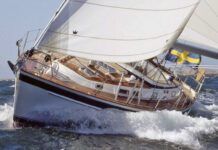
Hallberg-Rassy 42 Used Sailboat Review

How to Perform Your Own Pre-Buy Inspection

Thinking Through a Solar Power Installation

How Does the Gulf Stream Influence our Weather?

Can You Run a Marine Air-Conditioner on Battery Power?

Preparing Yourself for Solo Sailing

Practical Sailor Classic: The Load on Your Rode

Anchor Rodes for Smaller Sailboats


Ground Tackle Inspection Tips

Shoe Goo II Excels for Quick Sail Repairs

Diesel Performance Additives

What Oil Analysis Reveals About Your Engine

Painting a New Bootstripe Like a Pro

Penetrating Epoxy—Another Marketing Gimmick?
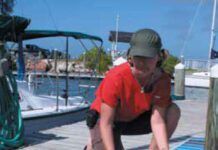
The Best Tools for Bottom Painting

The Hidden Maintenance Problems That Can Ruin Your Day: Part 1

Alcohol Stoves— Swan Song or Rebirth?

Living Aboard with an Alcohol Stove

Choosing the Right Fuel for Your Alcohol Stove

How to Select Crew for a Passage or Delivery

Preparing A Boat to Sail Solo

Re-sealing the Seams on Waterproof Fabrics

Waxing and Polishing Your Boat

Reducing Engine Room Noise

Tricks and Tips to Forming Do-it-yourself Rigging Terminals

Marine Toilet Maintenance Tips

Learning to Live with Plastic Boat Bits
- Sailboat Reviews
Columbia 8.7
A good entry-level coastal cruiser that offers a large interior volume and long waterline for her length..
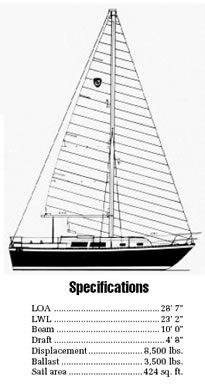
The Columbia 8.7 was one of the first of a series of modern small cruisers built by Columbia in the late 1970s. All were given metric length designations to distinguish them from Columbias older boats, most of which were designed by Bill Tripp. The metric Columbias-the 7.6, 8.7, 9.6, 10.7 and 11.8-were drawn by Alan Payne, the Australian who designed the Americas Cup challengers Gretel and Gretel II, two of the more competitive boats to participate in the Cup races prior to 1983.
Columbia labeled the entire Payne line as widebody supercruisers, the implication being that the boats were designed exclusively for cruising, and that you were getting more boat per foot of length. In fact, the metric Columbias are a few inches beamier than most other modern cruisers of the late 1970s, and quite a bit wider than slightly olderstyle cruising boats of the same period. By way of comparison, the Cape Dory 28 has a beam of 8′ 11″; the Ranger 28, 9′ 7″; the Newport 28, 9′ 7″; and the Cal 2-29, 9′ 3″.
The Columbia 8.7 had a checkered production history, spanning more than a decade. After her introduction in 1976, the 8.7 was built by a variety of companies, including Columbia as a division of Whittaker Corporation, Hughes Columbia, and Aura.
As with any boat that has been built by several different companies, opinions vary about who built the best Columbia 8.7. Our owners surveys do not reveal any definite pattern of superiority among any of the three builders that were involved with the boat: owners of boats from all three companies tend to believe that their boats are better than earlier or later incarnations.

For better or worse, the Columbia 8.7 is modern in appearance, with a very straight sheer, pronounced forward overhang, and no overhang aft. The stern is decidedly unusual, with an exaggerated wineglasssection transom. This reduces the apparent size of the back end of the boat, which would otherwise look very ungainly since beam is carried well aft. From an aesthetic point of view, you either like the stern or you don’t.
This is a plain vanilla boat. It has an off-white hull, off-white decks, and off-white non-skid. The only contrast is the aluminum toerail and a very few pieces of exterior teak trim. On the plus side, this means minimum maintenance: on the minus side, it means undistinguished appearance.
As is true of many small cruisers that strive to get more headroom without increasing freeboard to an ungainly height, the Columbia 8.7 has a fairly high,
boxy deckhouse. The underwater form of the boat is unusual. It features a double-stepped skeg and bustle, which was a fairly radical way of thinking at the time. The lower skeg eliminates a prop strut, and provides protection for the prop.
Sailing Performance
You might think that a cruising boat designed by one of the more successful 12-meter designers would be a real screamer under sail. But the 8.7 is about 500 to 1,000 pounds heavier than other boats of her size and type, while the rig is about average in size. In winds of below about 10 knots, owners report that the boat is no faster than other boats of her type.
This mediocre light-air performance is borne out by the boats PHRF ratings. In areas of light air, the boat rates as high as 222; in breezier sailing areas such as San Francisco, the rating drops as low as 192.
One big performance plus is the boats balance under sail. A large number of owners say the boat is perfectly balanced on all points of sail, and in all wind velocities. Part of this probably stems from the shape of the stern. The pronounced tuck in the stern that creates the wineglass transom also creates a fairly symmetrical waterplane, which stays symmetrical as the boat heels.
The 8.7 is quite stiff. The hull is slab-sided amidships, with a hard bilge turn that is practically a chine. This form provides a lot of initial stability as well as increasing interior volume.
Since the shrouds are set well inboard, headsail sheeting angles can be quite narrow. The genoa track is tucked close alongside the cabin trunk, keeping it out of the way. For reaching, snatch blocks can be attached to the slotted aluminum toerail.
The mainsheet traveler is recessed in the aft end of the bridgedeck at the forward end of the cockpit. This puts the three mainsheet blocks fairly close to the end of the boom, reducing the amount of effort needed to trim the main. The mainsheet is trimmed directly on the traveler using a block and cam cleat. This is a good arrangement for a boat this size. The helmsman can actually reach all the sheets, so the boat can easily be sailed by one person.
Originally, the boat was fitted with a tiller, which comes up through the deck at the aft end of the cockpit. This keeps the cockpit uncluttered. Some later boats were equipped with pedestal wheel steering, which eats up a lot of cockpit space.
There is simply no reason to have wheel steering on a well-balanced boat this size, other than some ego satisfaction that comes from thinking youre sailing a bigger boat. If you want to sit outboard to see the sails better, get a tiller extension. Its simpler and cheaper to install than a wheel.
You will find different rigs in the boat depending on when and where that particular boat was built, even though all have the same sail plan.
Aura-built 8.7s use a Cinkel rig, the extrusions and fittings of which are almost identical to those of Isomat. Cinkel spars are painted rather than anodized.
The original rig was neither anodized nor painted, so you may find corrosion in an older mast. Very early in the production run, there was a free factory retrofit which modified the masthead shroud tangs. It will be next to impossible to determine if this has been done on any particular mast, so you should carefully examine the masthead for any signs of metal fatigue or unusual wear.
All in all, the 8.7 is well-balanced and wellmannered under sail, though under-powered in light air. The deck layout is fairly performance-oriented, but this works just as well for cruising as it does for racing. The 8.7 was never touted as a racer, and it isn’t. But it has very adequate performance for family cruising and daysailing.
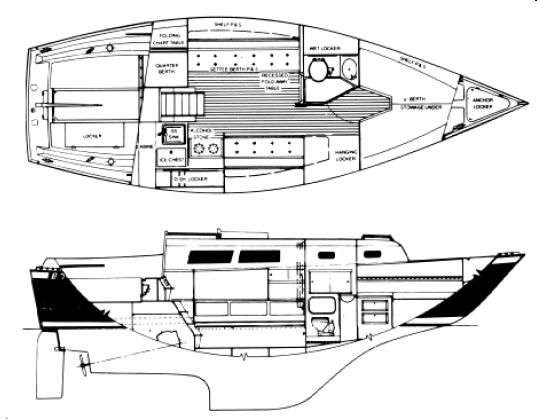
A wide variety of engines have been fitted in the Columbia 8.7. The original engine was the gas Atomic Two, with a Volvo MD6B diesel as an option. Very few boats probably have the Atomic Two. By 1978, the larger Atomic Four gas engine was standard, with the Volvo diesel still an option.
When Hughes Columbia took over production from Columbia, they retained the Atomic Four, but changed the optional diesels to the Volvo MD-7A, with 13 hp, or the Yanmar 2QM15, with 15 hp. A few boats were also fitted with the Yanmar 3GMD, a three-cylinder engine rated at 22.5 hp.
With the Atomic Two, we think the boat would be underpowered by modern standards. Likewise, some owners of the smaller Volvo diesel consider that engine to be a little small.
Engine choice is always a problem, and seems even more so in a small boat like the 8.7. The weight of a larger engine can have a negative effect on sailing performance and trim in a small boat, and the greater fuel requirements of a bigger engine reduce cruising range for a given fuel capacity. At the same time, small boats seem really sensitive to being underpowered, particularly when trying to make way into a head sea. The small boat pitches more, losing forward momentum, and always seems to be the wrong size for the wave pattern.
Engine cost is a factor, too. Larger engines cost more than smaller engines. Adding $500 or $1,000 to the price of a 29′ boat by putting in a larger engine undoubtedly cost some sales, particularly to firsttime buyers who may not have understood the change in performance that may come from an extra 3-5 hp.
In a boat, the difference between 13 hp and 15 hp may mean a difference of a half knot in cruising speed, which can be significant if youre in a hurry to get somewhere. It can mean even more difference in power and speed when bucking a 3′ chop and 25- knot headwind.
The Yanmar 2QM15 is probably the best engine choice for the boat. One owner reported breaking two prop shafts when the shaft separated from the coupling in reverse. We have heard of similar problems with some Yanmar engines in other boats from this same period. We suspect the problem is related to early Yanmar engine mounts. Another part of the problem is probably the shaft itself, which is only 3/4″ in diameter, and has an unsupported run of about 4′ from the transmission to the stuffing box.
Engine instruments are mounted in a recess in the cockpit under the bridgedeck, while controls are mounted on the side of the cockpit well. This is a pretty good location for the instruments on a coastal cruiser, but it would be too close to the cockpit sole for an offshore cruiser that might take a lot of water into the cockpit in severe weather.
Engine access for service is excellent, although it requires disassembling the engine box behind the companionway ladder.
Construction
Boats from Columbia are known as middle-of-theroad production sailboats. The metric-series boats are different in many construction details from earlier Columbias, but owners responses to our survey suggest that these later boats were not significantly better or worse than their predecessors.
The Columbia 8.7 hull is an uncored laminate with integral longitudinal stringers. The interior is built up of plywood, rather than based on a fiberglass molding or body pan with wood trim. A plywood interior properly glassed to the hull can add significant stiffness.
Because the plywood interior is a structural component, you must make a careful survey of every secondary bond in the boat. A secondary bond is any bond made after the original hull lamination. In order to achieve strength comparable to the rest of the hull, careful surface preparation and workmanship are required for secondary bonds. Poor secondary bonds are unfortunately not rare in production sailboats, even though there is nothing in our owners surveys of the 8.7 to suggest that it is either better or worse than any other boat in this respect.
Several owners of early model 8.7s report leaking around non-opening, recessed cabin windows. Leaking ports should show up as water stains on the inside of the teak-veneered cabin trunk. A long-term cure for leaking ports requires complete removal and rebedding: recaulking is at best a temporary fix.
According to our reader surveys, the 8.7 has suffered from a common ailment in the production boatbuilding industry: inconsistency of detailing.
Some owners rave about finishing detail such as interior joinerwork and systems installation, some complain about its mediocre quality. Some of these differences are in the eye of the beholder, while others are likely to be real. No production boat, no matter how carefully construction is supervised, will have absolutely consistent quality from one hull to another.
Companionway dropboards and hatch are teakveneered plywood. While dimensionally stable, teak plywood has to be kept varnished when exposed to the weather, or the veneer will very quickly erode away after a few cleanings.
Owners report that cockpit and deck drainage is a problem. An aluminum toerail can trap water on deck, and improperly-designed cockpit seats can pocket water on the leeward side.
Gelcoat is of typical production boat quality. Some owners report inconsistent gelcoat quality, crazing, and blistering, but the reports are average in frequency.
Another problem mentioned by several owners is rudder delamination. This is fairly common in twopiece rudders, and repair involves cleaning and drying the cracked area, then glassing over it. Merely forcing epoxy or polyester putty into the joint is not a suitable repair. Check for play between the rudder blade and rudder stock at the same time that you examine the rudder blade for flaws.
A big part of the widebody supercruiser concept was to get maximum interior volume in minimum length. The 8.7 achieves this by her slab-sided topsides and wide beam carried well aft. In fact, in both plan view and profile the boat looks like a 31-footer with the stern chopped off.
The interior of the 8.7 is big for a 28 1/2′ boat. Main cabin headroom is about 6′ 1″, and the headroom is carried out almost to the sides of the cabin. The cabin sole slopes upward forward of the mast, so that headroom falls off quickly in the head and forward cabin.
Ventilation belowdecks is poor. As originally built, the boat had three fixed ports per side, and a single aluminum-framed hatch over the forward cabin. There were no cowl vents or opening ports. Opening ports were optional on pre-Aura Hughes Columbia boats, and four opening ports- one each in head and
main cabin, two in forward cabin-were standard on Aura boats. Dorade vents over the head and passageway opposite were options on pre-Aura Columbia boats.
Because the original fixed ports were large, oddshaped, and recessed in the cabin trunk, installing opening ports in older boats is a problem. There is room, however, for a double-opening aluminum framed hatch over the main cabin between the main hatch and the mast, which would help ventilation in good weather. Cowl vents in dorade boxes can also be installed on either side of the sliding companionway hatch over the aft part of the main cabin.
Because the forward V-berths come almost to a point, they will not be comfortable for two people over 6′ tall. With the V-berth insert in place, the entire forward cabin becomes a reasonably large double berth, although you must remove the insert to get to the stowage areas below.
On a boat this size, it makes more sense to make the head the full width of the boat than to try to maintain the big-boat layout of the head off to one side. On the 8.7, the head is still further reduced in size to make it easier to get into the forward cabin. This is not a head compartment for large people.
Opposite the head is a hanging locker and a threedrawer bureau. While drawers waste a lot of space, they are the best way to stow folded clothes. You don’t see too many drawers on boats this size. The foot of the starboard settee berth extends forward under the bureau. The backs of both settees swing up and out of the way to make wider berths for sleeping- a good design feature.
Aft of the port settee, there is a quarterberth tucked under the cockpit. Unlike the quarterberths on many small boats, the head of the berth on the 8.7 is not under the cockpit itself, so you wont get claustrophobic. The rudimentary fold-down chart table over the head of the quarterberth is nothing to write home about, but few 28 1/2-footers have anything better. A real nav station aint usually in the cards on a boat this size.
Pushing the starboard settee forward leaves the starboard aft end of the main cabin free for the galley, and its really a pretty good galley for a boat this size. A deep single Polar sink is standard-much better than the toy sinks frequently seen on small boats. There is also room for a two-burner gimballed stove with oven, which is a genuine luxury, although you wont find anything but an alcohol stove unless an owner has changed it. Owners comment that the insulation in the icebox leaves something to be desired.
Aft of the sink and icebox is a long locker with sliding doors, plus smaller lockers. All in all, this is a very serviceable galley for a 28′ boat.
Despite the lack of ventilation and the relatively dark teak joinerwork, this is a good interior-definitely a major selling point when the boat was introduced. It still looks modern today.
Conclusions
When the Columbia 8.7 was introduced, one of its big selling points was the large interior volume and long waterline for the boats overall length. In the last decade, the proportions of the 8.7 have become the norm, not the exception, for boats just under 30′.
Frequently, interior volume is one of the things you give up when buying an older boat. The aesthetic of the older small cruiser called for fairly short waterline, long ends, and relatively narrow beam.
The Columbia 8.7 and her sisters were not the first boats to feature more volume in less length, but they did it with fewer compromises than a lot of more modern cruising boats. The Columbia 8.7 does not look particularly dated, either inside or out. She is certainly not classic, either, despite what anyone may claim about her unusual stern shape.
Performance is about what you would expect from a small modern cruiser: only fair in light air, lively in breezes over 10 knots. Because of her excellent
balance under sail and relative stability, the boat would make a good entry-level coastal cruiser, even for relatively inexperienced sailors. The boat is not handicapped by poor hull shape or bad deck layout, which run rampant in small boats touted as cruisers rather than racers. Unfortunately, the term cruising sailboat has become equated with slow. That is true for a lot of small boats, but it need not be if designer and builder have done their homework.
Columbia has high name recognition, even though its boats were only middle-of-the-road in quality. When you want to sell a Columbia 8.7, you wont get blank stares. If we were shopping for a used 8.7, wed choose the latest model we could afford.
RELATED ARTICLES MORE FROM AUTHOR
Leave a reply cancel reply.
Log in to leave a comment
Latest Videos

An Italian Go Fast Sailboat – The Viko S 35 |...

What Is The Best Folding Bike For Your Sailboat?

The No Expense Spared Antigua 60 Cruising Sailboat Soolaimon

How To Buy Sails – With Joe Cooper
- Privacy Policy
- Do Not Sell My Personal Information
- Online Account Activation
- Privacy Manager
Great choice! Your favorites are temporarily saved for this session. Sign in to save them permanently, access them on any device, and receive relevant alerts.
- Sailboat Guide
Columbia 31
Columbia 31 is a 30 ′ 6 ″ / 9.3 m monohull sailboat designed by Charles Morgan and built by Columbia Yachts between 1965 and 1968.

Rig and Sails
Auxilary power, accomodations, calculations.
The theoretical maximum speed that a displacement hull can move efficiently through the water is determined by it's waterline length and displacement. It may be unable to reach this speed if the boat is underpowered or heavily loaded, though it may exceed this speed given enough power. Read more.
Classic hull speed formula:
Hull Speed = 1.34 x √LWL
Max Speed/Length ratio = 8.26 ÷ Displacement/Length ratio .311 Hull Speed = Max Speed/Length ratio x √LWL
Sail Area / Displacement Ratio
A measure of the power of the sails relative to the weight of the boat. The higher the number, the higher the performance, but the harder the boat will be to handle. This ratio is a "non-dimensional" value that facilitates comparisons between boats of different types and sizes. Read more.
SA/D = SA ÷ (D ÷ 64) 2/3
- SA : Sail area in square feet, derived by adding the mainsail area to 100% of the foretriangle area (the lateral area above the deck between the mast and the forestay).
- D : Displacement in pounds.
Ballast / Displacement Ratio
A measure of the stability of a boat's hull that suggests how well a monohull will stand up to its sails. The ballast displacement ratio indicates how much of the weight of a boat is placed for maximum stability against capsizing and is an indicator of stiffness and resistance to capsize.
Ballast / Displacement * 100
Displacement / Length Ratio
A measure of the weight of the boat relative to it's length at the waterline. The higher a boat’s D/L ratio, the more easily it will carry a load and the more comfortable its motion will be. The lower a boat's ratio is, the less power it takes to drive the boat to its nominal hull speed or beyond. Read more.
D/L = (D ÷ 2240) ÷ (0.01 x LWL)³
- D: Displacement of the boat in pounds.
- LWL: Waterline length in feet
Comfort Ratio
This ratio assess how quickly and abruptly a boat’s hull reacts to waves in a significant seaway, these being the elements of a boat’s motion most likely to cause seasickness. Read more.
Comfort ratio = D ÷ (.65 x (.7 LWL + .3 LOA) x Beam 1.33 )
- D: Displacement of the boat in pounds
- LOA: Length overall in feet
- Beam: Width of boat at the widest point in feet
Capsize Screening Formula
This formula attempts to indicate whether a given boat might be too wide and light to readily right itself after being overturned in extreme conditions. Read more.
CSV = Beam ÷ ³√(D / 64)
Derived from the Morgan designed ‘TIGER CUB’(1963?). TALL MAST: I: 37.5’ J: 11.33’ P: 33.0’ E: 14.5’
Embed this page on your own website by copying and pasting this code.
- About Sailboat Guide
©2024 Sea Time Tech, LLC
This site is protected by reCAPTCHA and the Google Privacy Policy and Terms of Service apply.
Press Herald
Account Subscription: ACTIVE
Questions about your account? Our customer service team can be reached at [email protected] during business hours at (207) 791-6000 .
- Local & State
Observe Memorial Day with these events in southern Maine
Tons of towns have parades and ceremonies happening Monday.

You are able to gift 5 more articles this month.
Anyone can access the link you share with no account required. Learn more .
With a Press Herald subscription, you can gift 5 articles each month.
It looks like you do not have any active subscriptions. To get one, go to the subscriptions page .
Loading....
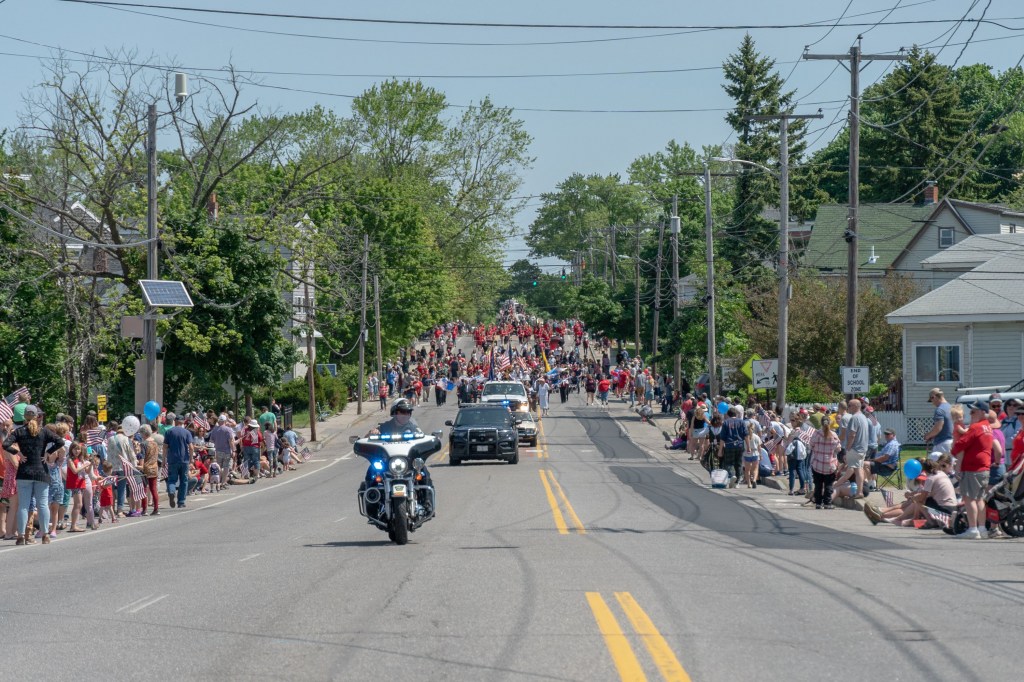
Kids and adults gather at a Memorial Day parade to honor and celebrate veterans in South Portland. Sofia Aldinio/ Staff Photographer
BATH 10 a.m. Monday. Parade begins at 200 Congress Ave. and concludes at Library Park and will be followed by a wreath-laying service at 11 a.m.
BERWICK 11 a.m. Monday. Parade begins at Berwick Town Hall/Sullivan Square and proceeds to Lord’s Cemetery by way of Wilson and Allen streets. After a ceremony there, the parade will continue down Saw Mill Hill Street with a pause at the Somersworth-Berwick Bridge for a brief memorial service for those lost at sea. The parade ends at Sullivan Square with a memorial service honoring area veterans.
BIDDEFORD-SACO Opening ceremony at 9:55 a.m. Monday at Saco City Hall. Parade starts at 10 a.m. from Saco City Hall and proceeds along Main Street and down York Hill into Biddeford, continues along Main Street, onto Alfred Street and finishes at Veteran’s Memorial Park with a closing ceremony at 10:45 a.m.
BRUNSWICK-TOPSHAM 9 a.m. Monday. Parade proceeds from Topsham Town Hall, pauses for observances while crossing the Brunswick-Topsham bridge, and concludes at the Brunswick Mall.
CAPE ELIZABETH 9 a.m. Monday. Parade begins at the middle school parking lot, turns right on Scott Dyer Road, right onto Route 77 and ends at the village green adjacent to the town hall. A brief ceremony and laying of the wreath will be held at the Village Green after the parade.
CUMBERLAND 8 a.m. Monday. Kids run at Greely High School followed by 5K Run and Remember race at 8:30 a.m. Parade starts at 10 a.m. at Mabel I. Wilson School and ends at the veterans’ monument in Moss Side Cemetery in Cumberland Center, where a ceremony will be held at 10:30 a.m. Advertisement
FALMOUTH 10 a.m. Monday. Parade proceeds from 65 Depot Road (Falmouth American Legion) to Pine Grove Park, where a ceremony will be held.
FREEPORT 9:30 a.m. Monday. Parade proceeds from Holbrook Street, heads north on Main and makes a right onto School Street, then right onto Park Street, ending in Memorial Park. There will be a small ceremony in Memorial Park starting at 10 a.m.
GORHAM 11 a.m. Monday. Parade starts at Village School (12 Robie St.) and ends at Eastern Cemetery on Johnson Road.
GRAY 11:30 a.m. Monday. Parade leaves the Russell School (8 Gray Park), proceeds to Shaker Road and continues to the Soldiers Monument at the intersection of Routes 26 and 3 for a wreath-laying ceremony. Parade continues north to the American Legion Post (15 Lewiston Road) for a closing ceremony.
LYMAN 1 p.m. Monday. Parade starts at Waterhouse Road/Mill Pond in Goodwins Mills and ends at the Lyman Town Hall on South Waterboro Road.
NEW GLOUCESTER 9 a.m. Monday. Parade leaves from Memorial Elementary School (86 Intervale Road) and heads down Intervale Road to Route 100/202 to Veterans Park for a memorial service. The parade will reconvene and go down Peacock Hill Road, then take a left on Gilmore Road. Advertisement
OLD ORCHARD BEACH 1 p.m. Monday. Parade starts at the corner of Ballpark Way and E. Emerson Cumming Boulevard and proceeds down Saco Avenue, Old Orchard Beach Street to First Street and ends at Veteran’s Memorial Park.
PORTLAND 2 p.m. Monday. The procession starts at Longfellow School (432 Stevens Ave.) and ends at Evergreen Cemetery for a commemoration ceremony.
SANFORD 10 a.m. Monday. The parade starts at the Sanford Armory (88 William Oscar Emery Drive), proceeds up Gowen Park Drive and ends at Central Park.
SCARBOROUGH 10 a.m. Monday. Parade starts at Scarborough High School, turns onto Route 114 and then Route 1, past town offices to the Maine Veterans Home and concludes with a ceremony there.
SOUTH PORTLAND 10:30 a.m. Monday. Parade starts at Southern Maine Community College parking lot, proceeds down Broadway to the Veterans Monument for a short Memorial Day recognition service.
WELLS 9 a.m. Monday. Parade starts at Wells High School (200 Sanford Road) and proceeds to Ocean View Cemetery for a ceremony and musical performances. Advertisement
WESTBROOK 10 a.m. Monday. Parade proceeds down Main Street and will be followed by a ceremony in Riverbank Park.
WINDHAM 9 a.m. Monday. Parade starts at Windham Town Hall and proceeds onto Route 202 toward Windham High School. At 10 a.m., there will be a ceremony in front of Windham’s Veterans Memorial Flagpole at Windham High School.
YARMOUTH 10 a.m. Monday. Parade leaves from Yarmouth High School (286 West Elm St.) and proceeds to the Memorial Green at Town Hall for a ceremony.
YORK 10 a.m. Monday. Parade starts near St. Christopher’s Church (4 Barrell Lane) and proceeds down York Street to York Town Hall.
Success. Please wait for the page to reload. If the page does not reload within 5 seconds, please refresh the page.
Enter your email and password to access comments.
Forgot Password?
Don't have a commenting profile? Create one.
Hi, to comment on stories you must create a commenting profile . This profile is in addition to your subscription and website login. Already have a commenting profile? Login .
Invalid username/password.
Please check your email to confirm and complete your registration.
Create a commenting profile by providing an email address, password and display name. You will receive an email to complete the registration. Please note the display name will appear on screen when you participate.
Already registered? Log in to join the discussion.
Only subscribers are eligible to post comments. Please subscribe or login first for digital access. Here’s why .
Use the form below to reset your password. When you've submitted your account email, we will send an email with a reset code.
Send questions/comments to the editors.
‘American Idol’ star Julia Gagnon to pursue a career in music, starting with a Maine tour
In camden, a story of wealthy neighbors, ocean views and over $1.7 million in fines, cracking the ‘recode’ that could decide portland’s housing future, right-wing protest banner adds new wrinkle to maine flag referendum, brunswick starts overhaul of downtown sidewalks, sparking concern among businesses, daily headlines.
- Email address
- Hidden Untitled
- Name This field is for validation purposes and should be left unchanged.
Member Log In
Please enter your username and password below. Already a subscriber but don't have one? Click here .
Not a subscriber? Click here to see your options

COMMENTS
A Ballast/Displacement ratio of 40 or more translates into a stiffer, more powerful boat that will be better able to stand up to the wind. Bal./Disp = ballast (lbs)/ displacement (lbs)*100 Disp./Len.: The lower a boat's Displacement/Length (LWL) ratio, the less power it takes to drive the boat to its nominal hull speed. less than 100 ...
0. The Columbia 30 is being constructed and marketed by Columbia Yachts under the direction of Vince Valdes, son of Dick Valdes, who formed the original Columbia Yacht company in 1958. At age 25, Valdes the elder, partnered with Maurice Thrienen to form Glass Laminates for the purpose of building fiberglass sailboats.
The Columbia 30 has a simple sail plan, with a dominant main and a small jib on a roller-furling headstay. The retractable bowsprit allows a shorthanded crew to cope with an asymmetric spinnaker and will coax a fun sail out of 5 knots of breeze. Advertisement. Down below, simplicity reigns with two comfortable quarter berths, a forward V-berth ...
The Columbia 30 is a 30.0ft masthead sloop designed by William Tripp Jr. and built in fiberglass by Columbia Yachts between 1971 and 1973. 287 units have been built. The Columbia 30 is a moderate weight sailboat which is a reasonably good performer. It is reasonably stable / stiff and has an excellent righting capability if capsized.
Columbia 30 is a 29′ 11″ / 9.1 m monohull sailboat designed by William H. Tripp Jr. and built by Columbia Yachts between 1971 and 1973. ... The lower a boat's ratio is, the less power it takes to drive the boat to its nominal hull speed or beyond. Read more. Formula. D/L = (D ÷ 2240) ÷ (0.01 x LWL)³ D: Displacement of the boat in pounds ...
The new Columbia 30 would have attracted attention even if it were just an average white boat. The resurrection of Columbia Yachts is a story in itself. But Vince Valdes has grander aims than just bringing his father's old company back to life.The marketplace will have to decide what to make of a high-end 30-foot sportboat that's weekend-cruiser friendly, but Valdes is betting plenty of
LOA: 30' 0" LWL: 27'0" Beam: 9' 6" Draft (keel up): 2"8" Draft (keel down): 7' 0" Displacement: 3995 lbs. Bowsprit extends I and J as shown in I2 and J2 columns. Complete Sail Plan Data for the Columbia 30 Sport Yacht Sail Data. Sailrite offers free rig and sail dimensions with featured products and canvas kits that fit the boat.
If you are a boat enthusiast looking to get more information on specs, built, make, etc. of different boats, then here is a complete review of COLUMBIA 30. Built by Columbia Yachts and designed by William H. Tripp Jr., the boat was first built in 1971. It has a hull type of Fin with rudder on skeg and LOA is 9.14.
Columbia Yachts will introduce their first model next year - a 30' sport sailer designed for performance-minded enthusiasts who also desire ease of use and comfort, at a highly competitive price. "Columbia Yachts became popular in the early1960's, because they produced well-designed, well-built vessels that met the needs of the sailor," said ...
If you're looking for a fun hobby this weekend, then consider sailing. Small lakes and inland waters are perfect environments for sailing adventures. The U.S.… Read more: What are the Best and Budget-Friendly Trailerable Sailboats in 2022?
R. rvarnes Discussion starter. 11 posts · Joined 2009. #1 · Aug 24, 2009. I'm interested in a 1973 columbia 30' sailboat, and was wondering if anyone out there has any experiance with them or can give me any advice. Thanks. Like. Sort by Oldest first.
The 1974 Columbia 30 sailboat has a fiberglass hull and has an overall length of 30 feet (sometimes referred to as LOA). The width (or beam) of this craft is 96 inches. This boat is rigged as a Sloop. The sail area for the sailboat is 515 square feet. The displacement for the boat is approximately 10800 lbs.
Columbia 30 of sailing boat from yard Columbia Yachts. 2313.0 , 0 , columbia-30 , Columbia Yachts , 2156 , Sailing boat , Columbia 30 , 9.14 , 1.83 , 2.9 , 8.08 ...
The Columbia 8.7 was one of the first of a series of modern small cruisers built by Columbia in the late 1970s. All were given metric length designations to distinguish them from Columbias older boats, most of which were designed by Bill Tripp. The metric Columbias-the 7.6, 8.7, 9.6, 10.7 and 11.8-were drawn by Alan Payne, the Australian who ...
This Columbia 30 sailboat has a fiberglass hull and an LOA of 29.92 feet (length over all). The boat has a 96 inch beam. This sailboat is set up to sail as a Sloop. The craft has 515 square feet of sail area. Displacement for the boat is 10800 lbs. The draft of this sailboat is approximately 5'9".
Boats Group does not guarantee the accuracy of conversion rates and rates may differ than those provided by financial institutions at the time of transaction. Find Sail Columbia Yacht 30 Sport boats for sale in your area & across the world on YachtWorld. Offering the best selection of Columbia Yacht to choose from.
Columbia 31 is a 30′ 6″ / 9.3 m monohull sailboat designed by Charles Morgan and built by Columbia Yachts between 1965 and 1968. ... The lower a boat's ratio is, the less power it takes to drive the boat to its nominal hull speed or beyond. Read more. Formula. D/L = (D ÷ 2240) ÷ (0.01 x LWL)³ D: Displacement of the boat in pounds. LWL ...
Main page; Contents; Current events; Random article; About Wikipedia; Contact us; Donate; Help; Learn to edit; Community portal; Recent changes; Upload file
Complete Sail Plan Data for the Columbia 30 Sail Data. Sailrite offers free rig and sail dimensions with featured products and canvas kits that fit the boat. ... Sailboat Data ; Columbia 30 Sail Data ; Columbia 30 Sail Data. Pinit. SKU: X-SD-5010 . Quantity discounts available . Quantity Price; Quantity -+ Add to Cart . Details. Details. LWL 26 ...
11:30 a.m. Monday. Parade leaves the Russell School (8 Gray Park), proceeds to Shaker Road and continues to the Soldiers Monument at the intersection of Routes 26 and 3 for a wreath-laying ceremony.
New Harken furler and new forestay - Rochester Sailing Services ; All standing rigging inspected by Rochester Sailing Services; New Jabsco head ; 2022. New shelf and refinshed woodwork in head; 2022 Summer dock at Shumway Marine conveys with sale; Equipment and Information: Builder/Designer. Builder: Catalina. Dimensions. LOA: 30' LWL: 25' Beam ...